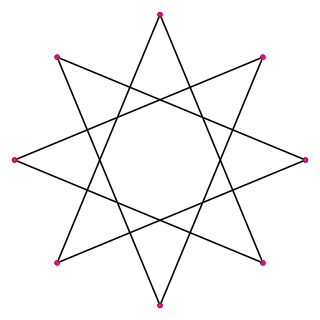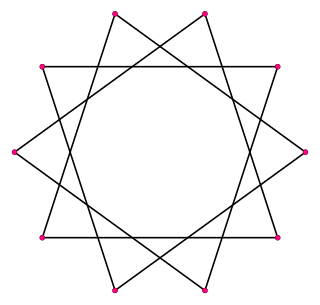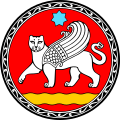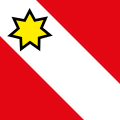
In geometry, stellation is the process of extending a polygon in two dimensions, polyhedron in three dimensions, or, in general, a polytope in n dimensions to form a new figure. Starting with an original figure, the process extends specific elements such as its edges or face planes, usually in a symmetrical way, until they meet each other again to form the closed boundary of a new figure. The new figure is a stellation of the original. The word stellation comes from the Latin stellātus, "starred", which in turn comes from Latin stella, "star". Stellation is the reciprocal or dual process to faceting.

A pentagram is a regular five-pointed star polygon, formed from the diagonal line segments of a convex regular pentagon. Drawing a circle around the five points creates a similar symbol referred to as the pentacle, which is used widely by Wiccans and in paganism, or as a sign of life and connections. The word "pentagram" refers only to the five-pointed star, not the surrounding circle of a pentacle.

A hexagram (Greek) or sexagram (Latin) is a six-pointed geometric star figure with the Schläfli symbol {6/2}, 2{3}, or {{3}}. Since there are no true regular continuous hexagrams, the term is instead used to refer to a compound figure of two equilateral triangles. The intersection is a regular hexagon.

In geometry, a star polygon is a type of non-convex polygon. Regular star polygons have been studied in depth; while star polygons in general appear not to have been formally defined, certain notable ones can arise through truncation operations on regular simple and star polygons.
A regular polyhedron is a polyhedron whose symmetry group acts transitively on its flags. A regular polyhedron is highly symmetrical, being all of edge-transitive, vertex-transitive and face-transitive. In classical contexts, many different equivalent definitions are used; a common one is that the faces are congruent regular polygons which are assembled in the same way around each vertex.
In Euclidean geometry, a regular polygon is a polygon that is direct equiangular and equilateral. Regular polygons may be either convex, star or skew. In the limit, a sequence of regular polygons with an increasing number of sides approximates a circle, if the perimeter or area is fixed, or a regular apeirogon, if the edge length is fixed.

In geometry, a heptagon or septagon is a seven-sided polygon or 7-gon.

In geometry, the Schläfli symbol is a notation of the form that defines regular polytopes and tessellations.

In geometry, an octagram is an eight-angled star polygon.
Star polygons and polygonal compounds are the basis for numerous figures of significance in arts and culture. The figure may be the border or interior of the polygon, or one or more closed polygonal paths that include all of the border and also have some legs crossing the interior. The name is derived from the polygon's similarity to the diffraction spikes of astronomical stars, but specific uses may exploit the connection or not. Stars often represent the unity of states within a country when they are used as a part of the flag.

In geometry, a tetradecagon or tetrakaidecagon or 14-gon is a fourteen-sided polygon.

In geometry, a decagram is a 10-point star polygon. There is one regular decagram, containing the vertices of a regular decagon, but connected by every third point. Its Schläfli symbol is {10/3}.

In geometry, a dodecagram is a star polygon or compound with 12 vertices. There is one regular dodecagram polygon. There are also 4 regular compounds {12/2},{12/3},{12/4}, and {12/6}.

In geometry, an enneagram is a nine-pointed plane figure. It is sometimes called a nonagram, nonangle, or enneagon.

In geometry, a generalized polygon can be called a polygram, and named specifically by its number of sides. All polygons are polygrams, but can also include disconnected sets of edges, called a compound polygon. For example, a regular pentagram, {5/2}, has 5 sides, and the regular hexagram, {6/2} or 2{3}, has 6 sides divided into two triangles.





















![Seal of Babalon and the A[?]A[?] Babalon seal.png](http://upload.wikimedia.org/wikipedia/commons/7/76/Babalon_seal.png)













